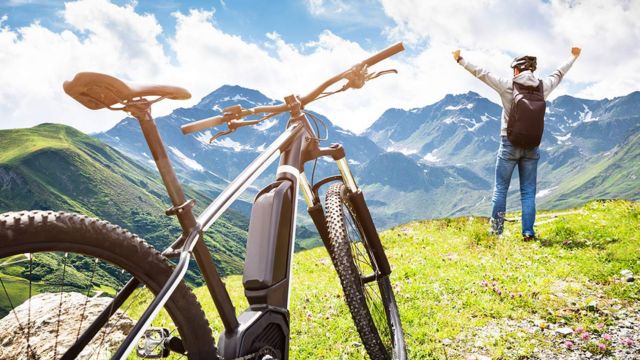
Safe, healthful, and environmentally friendly modes of transportation have been increasingly important since the COVID-19 epidemic. Bicycle tourism, for example, has recently seen a boom in interest. Bicycle vacations are attractive for a variety of reasons. It’s a fun way to see the world while getting some fresh air and exercise. It’s accessible to people of varying levels of fitness and costs little in terms of time and money.
There has been an increase in bike-friendly infrastructure all across the world in recent years. Several long-distance bike paths now span the world, and many urban areas have installed bike lanes. This has made bike riding more convenient and fun, contributing to the recent uptick in interest.
Bicycle Tourism Grows All Over the World
Many local governments throughout the world have begun investing in cycling infrastructure and subsidizing repairs for cyclists up to 50 euros at approved repair shops.2 New bike lanes and slower speed restrictions for cars have been installed on major thoroughfares in London, Brussels, and Bogota.3
Citizens took to riding regardless of whether their government actively encouraged it throughout the outbreak. Bicycle advocates in Abidjan, Ivory Coast, and Nairobi, Kenya, asked their respective governments to build extra bike lanes after seeing an increase in the number of cyclists who took to the streets outside of designated bike lanes in order to escape crowded public transportation and the possibility of disease.
4 Individuals in these countries demonstrated that while official backing was important, it was not the driving force behind the bicycle craze.
Some of these cyclists purchased or dusted off their pre-existing bikes as a means of commuting to and from employment, medical care, or other necessities; others did so as a healthy, enjoyable alternative to driving. Even before the epidemic hit, the idea of exploring a new city by bike held a lot of allure.
Is Bike Travel a Sustainable Trend?
At some point, life will return to normal, and people will feel secure enough to travel by more traditional forms of transportation, such as aircraft, trains, and other shared areas, whether for vacations or day-to-day activities. However, during the pandemic, bicycles became indispensable to many people.
“One of the most concerning aspects of the pandemic is that we have no control over it,” Taylor says. “We have an innate desire for control.” Biking, at its most basic, gives us a sense of control in terms of exercising our bodies and staying healthy…a means to escape the pandemic’s strains and anxieties. Overall, it has a wide range of psychological, emotional, and physical benefits.”
That loss of control sent us onto our bikes. When cars, trains, and other modes of transportation felt hazardous, millions of people turned to biking for refuge. But, as normalcy returns, what will this shift toward leisure bike travel mean?
“My guess is that the amount of time spent biking will decrease,” Taylor predicts. “At the same time, the sheer volume and miles ridden now compared to previous years, it’s never going back to the way it was.”
Rails to Trails Conservancy data (a non-profit that aims to convert rail routes into trail networks) backs up his prediction. In 2020, the organization tracked weekly trail use by cyclists in the United States. Except for one week since the pandemic began, trail ridership has grown. Last year, ridership peaked in the first week of April, climbing 217 percent year over year from 2019; by mid-December, it had declined to a 26 percent increase from the same period in 2019.

Nonetheless, the 26 percent growth is a huge gain over the prior year. Perhaps the most important lesson learned from bike travel during the pandemic is that we can do it and that it is a realistic alternative for short and sometimes lengthy travels. “More people are realizing you don’t need to drive three blocks to go to the supermarket,” Taylor adds.
Reasons the Enthusiasm for Bike Travel is Here to Stay
As we continue to forecast which trends from the previous year will fade and which will persist, we hope that bike travel is one of the few that endures. Undoubtedly, more traditional forms of transportation will make a comeback, diminishing some people’s necessity or willingness to commute by bike. So, what will be the impetus for encouraging two-wheeled travel? Here are four reasons why this tendency could continue.
The Environmental Impact:
There is one obvious benefit and reason why riding should become more common for some people: it is an excellent eco-friendly means of transportation. In 2019, the Environmental Change Institute and Transport for London conducted a research in Cardiff, Wales, comparing the effects of substituting short travels (eight kilometers or less) by automobile with bikes.
They discovered that walking or cycling may replace up to 41% of all car journeys, resulting in a 5% reduction in CO2 emissions in the city. Other studies have used comparable statistics to measure the same thing in Barcelona, New Zealand, and the United States.
Because biking reduces greenhouse gas emissions, the United Nations’ Intergovernmental Panel on Climate Change advocated switching from vehicle commuting to biking as a means to keep global temperatures from rising. More benefits of biking are being uncovered as more studies are published.
According to a Swedish study, 111,000 vehicle commuters in Stockholm might feasibly switch to biking, reducing black carbon and nitrogen oxide in the air and saving the general public 449 years of life per year.
Mental Health Benefits:
Mental health will become a driving motivation for some. In the early months of the pandemic, there was a severe quarantine in Buenos Aires, which contributed significantly to reductions in mental health. The National University of La Matanza performed a poll on the effects of the quarantine on inhabitants’ mental health after 100 days of a lockdown in which residents could only leave their homes to buy food or medicine.
They discovered that 43.8 percent of individuals polled needed psychiatric help because of pandemic-related anxiety, despair, hopelessness, and emotional instability.
When the quarantine lifted and we were able to exercise outside again, we hopped on our bikes, and the bicycle quickly became the most popular mode of transportation in the country, according to Google Maps data. Bicycle ridership soared by 98 percent in Buenos Aires. This was partly because public transit was still confined to just critical personnel, but it was also because people needed to be outside.
Improvements to Bike Infrastructure:
National and municipal governments are also important in sustaining interest in biking. While popup lanes in Buenos Aires have helped to reduce traffic congestion and pollution, governments must make long-term improvements to see long-term results.
In Buenos Aires, the city government has set a goal of having one million bike rides every day by 2023.5 Throughout the pandemic, the city collaborated with the Bloomberg Initiative for Global Road Safety to increase riding infrastructure, increasing from 227 kilometers in September 2020 to 267 kilometers by January 2021.6 One significant alteration has been the construction of bike lanes to important routes such as Corrientes and Córdoba avenues, rather of just side streets, as was the case before to the pandemic.
The Appeal of Bike Travel:
Others will be motivated by the challenge and novelty of taking a long-distance leisure vacation by bike, whether they are new to this sort of travel or have previously liked it. Yvan Frasier, a French-Canadian, had been journeying for a year and a half from Canada’s Northwest Territories to the tip of South America when the epidemic struck, and he was forced to stop in Argentine Patagonia.
When asked if he believes a bigger proportion of the world population will continue to take long-distance bike excursions in the aftermath of the pandemic, he is upbeat: “I think [the pandemic] just made a lot of people realize that life is pretty fragile.” I guess that’s why people want to get out in nature and ride their bikes for some simple, healthy fun.”
We don’t know when or how our lives will return to pre-2020 normalcy, but perhaps riding as a mode of transportation is here to stay for many people, remaining front of mind when we need to get someplace. In other words, the next time you plan a trip—whether to the grocery store or to a nearby city—ask yourself, “Can I bike there?”



